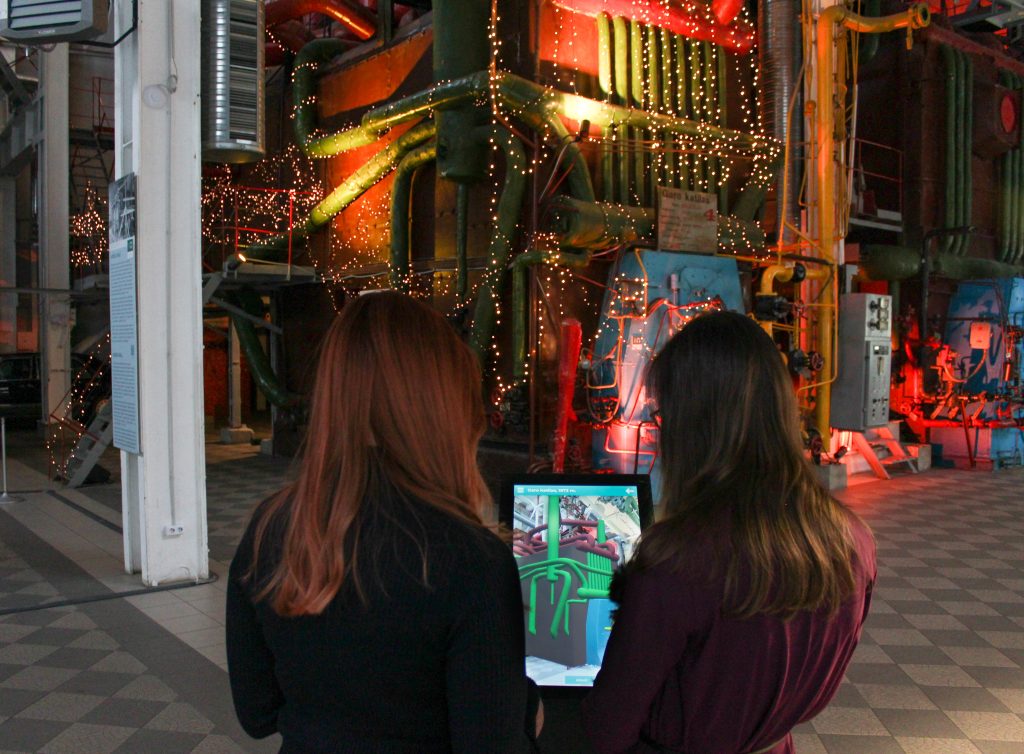Energy and Technology Museum implemented a new project – authentic museum equipment was recreated with the help of augmented reality.
The former first power plant of the city of Vilnius was stopped in 1998. Authentic devices, boilers and turbines have been preserved in the Energy and Technology Museum established here. Now only guides tell visitors about them. However, it is difficult to explain verbally how a steam boiler that reaches a temperature of 1400 degrees inside works or how a turbine rotates and generates electricity. The museum used modern technologies to illustrate their operation.
A tangle of pipes
The new interactive stands complemented the museum’s Boiler and Turbine Halls. From December, visitors can see an authentic view of the steam boilers and turbines and how the facilities worked and looked in the past. With the help of augmented reality, it is revealed how turbines convert the thermal energy of steam into mechanical energy and how boilers produce steam in individual complex parts.


In cooperation with representatives of creative industries, “MultimediaMark”, museum has applied augmented reality technology, with the help of which real objects are represented by computer graphics elements. “The purpose of the work is to interest, intrigue, and then to familiarize the visitor with the basic principles of steam boiler and turbine operation. To show and clearly visualize how these devices work,” said Jokūbas Bernotas-Pakeris, 3D designer of “MultimediaMark”.
How does the boiler work? Challenges have already arisen in this part of the project. “If the operation of the turbine – the rotor – is quite clear, then the steam boiler is a whole tangle of pipes and labyrinths. Not only on the outside, but on the inside as well. More than once, I clarified, made adjustments, did 3D scans, went to the boiler with a searchlight and climbed on it. After finding out the principle of its operation, we also had to create a visual system that would work on a simple Android system,” recalled Bernotas-Pakeris, who spent about two months at the museum.


We will have a new engineer
The developer consulted with museum employees, engineers and the Lithuanian Energy Seniors Club. Club members worked at the power plant when it was still operating, so their knowledge is relevant and informative.
“Energy was mostly overseeing production, so when there were a lot of fundamental questions now, it made us all dig deeper. Finally, when we sifted through all this information, we had to choose – what do we want to show the visitor? Impressively, but also clearly enough, precisely. Today, the attention span of young people is getting shorter and shorter. Through it, we must be able to meaningfully show what we want. And those who are interested will stay longer in the museum,” Bernotas-Pakeris is convinced.
Why does it make sense to learn about how vintage equipment works? “In the beginning, I imagined both the boiler and the turbine as extremely complicated, although they actually work quite simply. This is a hint to us that we can understand something particularly complicated quite easily. In this way, we destroy our imagination of technical ignorance, which, by the way, often stops us from furthering our interest in science. And if any visitor is interested in it, “gets hooked”, we will have a new engineer,” said the interviewer.


Not just technologies of the past
The modern museum visitor is attracted by dynamic and interactive expositions. “Augmented reality technology allows you to look at authentic technical devices from the inside. It also enhances the visitor’s experience and changes how he/she understands and learns about the world. The use of such technologies can encourage us to better understand the science of physics, especially the younger generation. In order to interest them in science and attract to the museum, we need interactive and advanced solutions,” said the author of the project and cultural project coordinator at the Energy and Technology Museum Žara Kutkaitė.
Augmented reality stands are adapted for museum activities and guided tours. In addition, the project updated the museum’s smart app “Deeper Vision”, which can be downloaded on the “Google Play” platform. “In the museum, we have a power plant control panel simulator, a 3D model of a steam boiler, car structures that can also be “seen” with the help of augmented reality. I am convinced that the museums of the future will be full of interactive, augmented reality exhibits. In the Energy and Technology Museum, we aim not only to exhibit and show historical equipment, but also to keep pace with technology, science and innovation” said Kutkaitė.


The project was sponsored by the Lithuanian Council for Culture and Vilnius City Municipality.
Augmented reality stands are open in the Boiler and Turbine Halls during the working hours of the Energy and Technology Museum from Tuesday to Sunday from 10 AM to 6.30 PM.

